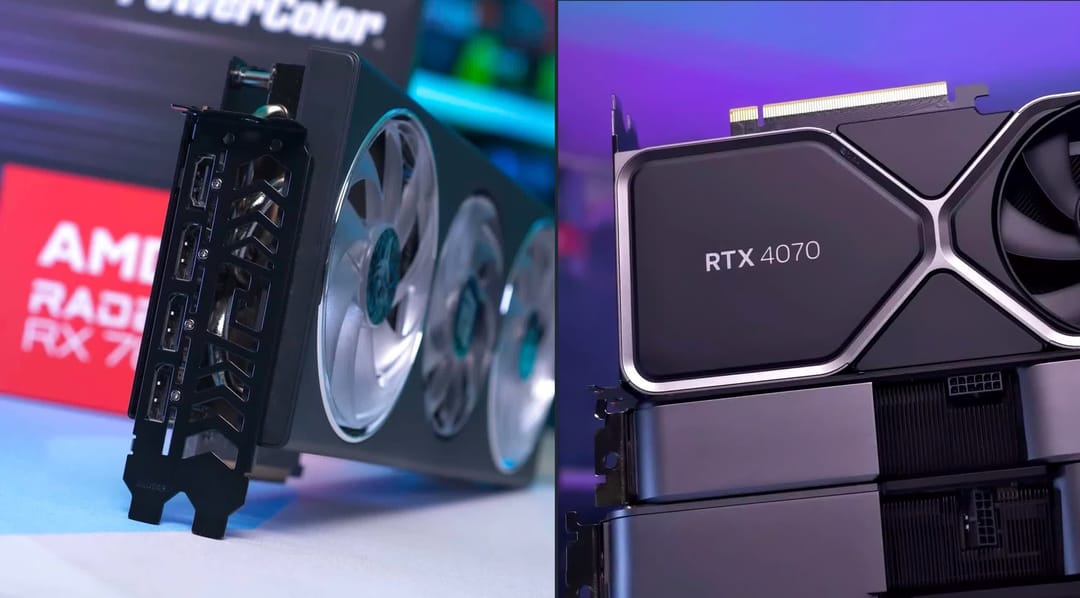If you’re shopping for a 1440p GPU in 2025, the NVIDIA GeForce RTX 4070 and AMD Radeon RX 7800 XT sit right in the sweet spot. They trade blows in traditional raster performance, diverge meaningfully in ray tracing, and offer different strengths on power, memory, and features. Here’s a clear, no-nonsense breakdown to help you choose the right card for your build.
TL;DR
Pure raster at 1440p: RX 7800 XT generally leads in many titles.
Ray tracing at 1440p: RTX 4070 pulls ahead decisively; in one large test suite it was about 21% faster with RT enabled.
Upscaling: DLSS 3 (with Frame Generation and strong adoption) is an advantage for the RTX 4070; FSR works on both cards and keeps improving.
Memory: RX 7800 XT’s 16 GB and 256-bit bus provide extra headroom for high-res textures.
Power/thermals: RTX 4070 is more efficient (~200W TGP) vs RX 7800 XT (~263W TBP).
Value call: If you favor raster and can get the 7800 XT meaningfully cheaper, it’s compelling. If you care about ray tracing, power efficiency, and DLSS features, the 4070 often justifies a higher price.
Quick Specs That Matter
- RTX 4070: 12 GB GDDR6X, 192-bit bus, ~200W TGP, DLSS 3 with Frame Generation, strong RT hardware.
- RX 7800 XT: 16 GB GDDR6, 256-bit bus, ~263W TBP, FSR support (vendor-agnostic), very solid raster performance.
That extra 4 GB and wider bus on the 7800 XT help with memory-heavy 1440p settings. Meanwhile, the 4070’s efficiency and Ada RT cores pay off in ray-traced titles and smaller builds.
1440p Rasterized Performance
Across a broad mix of modern games at 1440p (high/ultra settings, ray tracing off), the RX 7800 XT typically edges out the RTX 4070. In large test suites, the 7800 XT tends to post higher averages in many raster-bound titles. It’s not a landslide—but if your library is mostly non-RT games, the 7800 XT often offers a few extra frames for the money.
1440p Ray Tracing and Upscaling
Turn on ray tracing, and the story changes. In our game comparison, the RTX 4070 showed a meaningful advantage in ray-traced workloads at 1440p—around 21% faster in RT-focused look. NVIDIA’s RT hardware remains ahead, and DLSS support (including Frame Generation on supported titles) further amplifies fluidity.
FSR works on both cards and continues to improve, but DLSS still generally enjoys broader adoption and stronger image stability in many titles. If you actively seek out RT-heavy games—or you want the best combination of RT + upscaling—RTX 4070 is the safer bet.
VRAM, Settings Headroom, and Longevity
- RX 7800 XT’s 16 GB can be a quality-of-life win for high-resolution texture packs and future titles at 1440p, reducing the likelihood of having to dial back texture settings.
- RTX 4070’s 12 GB is workable at 1440p today in the vast majority of games, but heavy modding or ultra textures in a few titles can press that limit.
If you’re the “set everything to ultra and never think about it” type—or you plan on keeping the card several years—the 7800 XT’s memory configuration is appealing.
Power, Thermals, and Form Factor
RTX 4070’s ~200W TGP usually means cooler, quieter builds and fewer power supply constraints. It shines in compact PCs and efficiency-focused setups.
RX 7800 XT’s ~263W TBP isn’t excessive, but it typically draws more power and heat. Ensure your case airflow and PSU are up to snuff.
Drivers, Ecosystem, and Creator Workloads
NVIDIA: DLSS 3 (Frame Generation), Reflex, Broadcast, and mature creator app optimization (CUDA/Studio) can be decisive if you do video, 3D, or AI-accelerated work on the side.
AMD: FSR is vendor-agnostic and keeps getting better; Radeon software is clean and capable. If you don’t rely on CUDA-based tools, AMD remains a strong choice.
Pricing and Value in 2025
Street prices move. The value picture depends on what you can actually pay today:
If prices are close: prioritize features. Choose RTX 4070 for RT/DLSS/efficiency; choose RX 7800 XT for raster performance and 16 GB headroom.
If the RX 7800 XT is cheaper by ~$50–$100 or more: it’s often the better pure-gaming value at 1440p (raster-heavy).
If the RTX 4070 is the same price or lower: that tilts value toward NVIDIA given RT leadership and DLSS features.
Pro tip: Check current local pricing and promotions; bundles and regional availability can swing the recommendation.
Who Should Buy Which?
Pick the RTX 4070 if you:
- Play RT-heavy titles and want high, stable RT FPS at 1440p
- Value DLSS 3 with Frame Generation and broad game support
- Want lower power draw, cooler acoustics, or a small-form-factor build
- Use creator apps that benefit from CUDA/Studio optimizations
Pick the RX 7800 XT if you:
- Focus on raster performance and want the best 1440p frames-per-dollar
- Prefer 16 GB VRAM for texture-heavy games or longevity
- Don’t rely on CUDA-specific workflows and are happy with FSR
Conclusion
Raster-first gamer, price-sensitive: RX 7800 XT is often the smarter buy at 1440p.
RT enthusiast or efficiency-focused builder: RTX 4070 is the stronger, more balanced choice.
When in doubt, let your library—and current street pricing—decide.
If you want, share your target games and current local prices—I’ll give you a tailored pick based on your exact list and budget.

